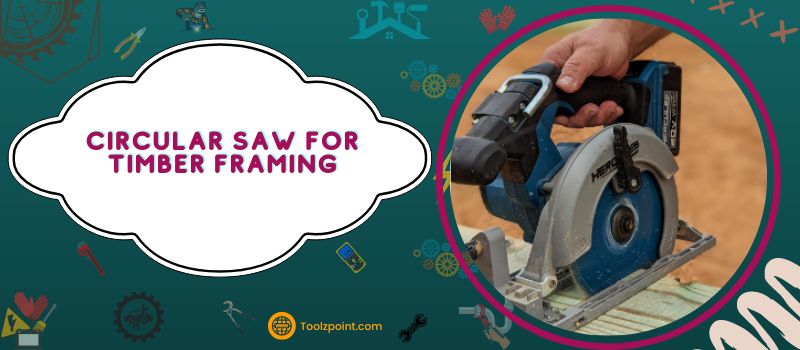Circular saws are the most prominent option for timber framing as they deliver precise and accurate cuts on any size of timber, no matter how large the pieces are.
For the best output of timber framing, the concerning circular saw much have some features such as blade size, power, cutting depth, blade type, corded or not, and a few more.
To learn in-depth about the features a circular saw must have for a timber saw, keep scrolling till the end.

Must-Have Features On Circular Saw For Timber Framing
When you are surfing for a circular saw for the purpose of timber framing, you must check some vital issues that impact the process of timber framing. The list may frighten you at a quick glance, but if you could follow this list, you will thank me after a productive timber framing session. So, let’s get started.
1. Blade Size
The parts of a circular saw are basically all ornaments while the blade is the showstopper. The blade’s importance for a smooth and clean cut is unparallel. Thus, first and foremost, you have to take the blade size into consideration. The blade size determines the depth of the cut on the timber. For timber framing, 7 ¼ inches blades are highly recommended.
2. Power
Normally there are no adjustable settings for power alternation. So, when you are browsing for a circular saw, make sure the power of the motor is eligible enough to facilitate timber framing. For this, you will need a regular circular saw with a motor that has at least 15 amps of power.
3. Weight
Timber framing is a tiresome task. It would be more tedious and wearing if the circular saw is weighty. A heavy circular saw is difficult to control and handle, especially if you are a novice. The circular saw for timber framing must be well-balanced and light as a feature.
4. Bevel Capacity
The capacity of the bevel denotes the ability of the circular saw blade to make angled cuts. An ideal circular saw for timber framing must have a bevel capacity of up to 45 degrees. A 45-degree capacity is most crucial for trimming timber and cutting the angled joints.
Most circular saws have a bevel capacity close to 45 degrees. So, make sure your saw has a positive stop at 45 degrees at least. This will make it easier for you to set the saw to the correct angle.
5. Ergonomics
A well-designed circular saw makes the task a lot easier and more comfortable. Give some notice on the grip, handle, vibration, sawdust-reducing technology, etc. You should opt for rubberized handles and anti-vibration technology that will provide you with the utmost comfort and control.
6. Dust Reduction Ability
Sawdust is a huge drawback for circular saws. Not only does it spawn lots of waste, but it also makes a huge mess around the workspace. The sawdust becomes a health hazard without proper gear. Also, such sawdust can distract your eyesight from the cutline making it blurry.
Recently some circular saws are appearing with built-in sawdust-collecting technology. This system retains the dust inside the saw in a separate compartment and keeps the workspace free from dust and debris. You just have to clean the compartment every once in a while.
7. Corded Or Cordless
Overlooking this feature is the mistake one makes very often. When you are buying a circular saw, you should consider where you are going to use it. If you are going to use the saw only inside your workstation within reach of a power outlet, you should go for a corded saw as it is more powerful.
However, if you don’t have a designated workstation and prefer to work in remote locations or travel around a lot, a cordless circular saw would be a better option. They’re very handy and convenient.
8. Blade Depth
The blade size is correlated to the maximum cutting depth of the blade. But as for timber framing, you should look for the circular saw with adjustable blade settings. This will allow you to cut different thicknesses of the timber. For precise cuts and thinner panels of timber, this feature adds great advantage.
9. Durability
Timber framing is a highly powerful task. A regular task will weaken the quality and performance of the circular saw. So, you should make sure the circular saw is durable and strong enough to withstand such heavy duty.
10. Type Of Blade
There is no hard and fast rule on the type of blade you should use for timber framing. You should select the blade type as per your requirement. If you want to cut with the grain, ripping blades would be best for you.
However, for cutting across the grain, you should go for crosscutting blades. Depending on the timber type such as hardwood or softwood, there are different types of blades for a circular saw.
11. Safety Features
A circular saw can cause lots of trouble if you don’t use it properly or if you are a beginner. So, make sure the circular saw is featured with optimum safety features to protect you from the blade. The blade guard is a must-have feature that covers the blade when you store the circular saw. Also, a safety switch is a must that deters you from accidental start-ups.
12. Brand And Price
A well-known brand doesn’t mean their product would be right for you. Also, an expensive tool doesn’t guarantee a better service. You need to look for a reliable brand with a reasonable price that could fulfill your requirements. Makita 5007MGA 7-1/4″ Magnesium Circular Saw is a safe and trustworthy circular saw you can consider.
13. Additional Accessories
Your life and circular saw don’t have to be basic and mundane. Some circular saws have additional features like laser guides and rip guides that can uplift your experience using that tool. Depending on your requirements and experience, you can choose a particular circular saw with particular features that might help you to improve the experience.
14. Warranty
Another important factor that people seem to overlook. A circular saw can be inflicted many issues. A sustainable warranty can protect against some of the damage for a certain period of time. Having a protection bubble over the tool can prove vital in the long run. You can also use a replacement card if any default pops up in the tool.
Some Tips To Remember

- A right blade can make the process of timber framing easier and the cut sharper. The proper number of teeth and tooth configuration varies depending on the timber.
- Use a straight edge or circular saw guide to make the cuts more accurate and straight. This will help you avoid mistakes.
- Before you begin cutting the timber, make sure the blade is on the proper depth setting. This depends on the thickness of the material.
- The blade you are using for timber framing must be sharp and coated with diamond particles or tungsten carbide. This reduces the risk of kickbacks and hazards.
- Make a few test runs on spare timbers before you run the blade on the actual timber. This will allow you to notice any fault on the circular saw.
People Also Ask

What other tools can you use for timber framing?
Apart from a circular saw, there are a number of tools that are programmed for efficient timber framing. The first name that pops out is the classic handsaw. Although it is a manual tool, it can provide the most precise cuts. Bow Saw, Japanese saw, chainsaw, beam saw, mortising machine, and Tenoning machine are some popular and competent tools for timber framing.
Does timber framing generate too much sawdust?
Timber framing breeds and accumulates excessive amounts of sawdust, especially when the cutting tool is a circular saw or chainsaw. Sawdust usually causes havoc around the workstation. If you are using a circular saw, make sure that has a dust-collecting mechanism. If your circular saw doesn’t have that feature, move your workspace outside or in a well-ventilated place.
How to identify good quality timber for framing?
Not only a tool but the material also has an impact for an accurate cut. You can recognize a good timber by some of the features on the panel. The first one is the shape of the grain. A straight grain denotes the good quality of the timber.
Also, other attributes such as consistent density, a few numbers of knots, no visible checks, and cracks are some of the most important factors to identify a good timber. Also, timber with a moisture content between 10-15% also vouches for good timber.
Final Words
Timber framing is the most vital and crucial technique in the construction industry. If you can master timber framing, you can master any sort of wooden work. And to make this process easy and effective, you should invest in a suitable circular saw. If you are thinking about what makes a circular saw suitable for timber framing, you can go through the list above.
